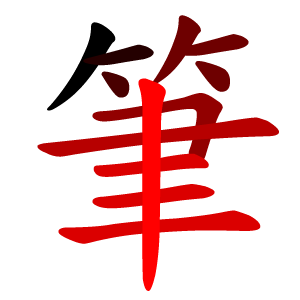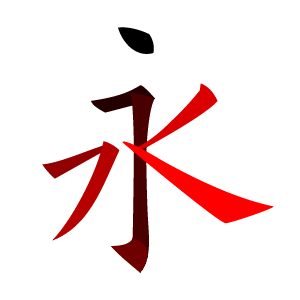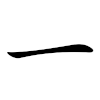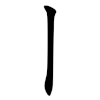Several input methods allow the use of Chinese characters with computers. Most allow selection of characters based either on their pronunciation or their graphical shape. Phonetic input methods are easier to learn but are less efficient, while graphical methods allow faster input, but have a steep learning curve.

The Wubizixing input method, often abbreviated to simply Wubi or Wubi Xing, is a Chinese character input method primarily for inputting simplified Chinese and traditional Chinese text on a computer. Wubi should not be confused with the Wubihua (五笔画) method, which is a different input method that shares the categorization into five types of strokes.
Traditional Chinese characters are one of several standard sets of characters used to write Chinese languages. In Taiwan, the set of traditional characters is regulated by Taiwan's Ministry of Education, standardized in the Standard Form of National Characters. These forms were predominant in written Chinese until the middle of the 20th century, when various countries that use Chinese characters began standardizing simplified sets of characters, often with characters that existed before as well-known variants of the predominant forms.

Stroke order is the order in which the strokes of a Chinese character are written. A stroke is a movement of a writing instrument on a writing surface. Chinese characters are used in various forms in Chinese, Japanese, and Korean. They are known as Hanzi in (Mandarin) Chinese, kanji in Japanese (かんじ), and Hanja in Korean (한자).

The Stroke Count Method, Wubihua method, Stroke input method or Bihua IME is a relatively simple Chinese input method for writing text on a computer or a mobile phone. It is based on the stroke order of a word, not pronunciation. It uses five or six buttons, and is often placed on a numerical keypad. Although it is possible to input Traditional Chinese characters with this method, this method is often associated with Simplified Chinese characters. The Wubihua method should not be confused with the Wubi method.
The surname stroke order is a system for the collation of Chinese surnames. It arose as an impartial method of categorization of the order in which names appear in official documentation or in ceremonial procedure without any line of hierarchy. In official setting, the number of strokes in a person's surname determines where a name should be placed and the list order. Surnames "Ding" and "Wang" for example, are simple surnames that usually appear on the front of lists, while surnames such as "Dai" and "Wei" often appear on the bottom of lists.

Taito, daito, or otodo is a kokuji written with 84 strokes, and thus the most graphically complex CJK character—collectively referring to Chinese characters and derivatives used in the written Chinese, Japanese, and Korean languages. This rare and complex character graphically places the 36-stroke tai䨺, meaning "cloudy", above the 48-stroke tō龘 "appearance of a dragon in flight". The second most complicated CJK character is the 58-stroke Chinese biáng, which was invented for Biangbiang noodles "a Shaanxi-style Chinese noodle".

WenQuanYi is an open-source project of Chinese computer fonts licensed under GNU General Public License.
The Table of Indexing Chinese Character Components is a lexicographic tool used to order the Chinese characters in mainland China. The specification is also known as GF 0011-2009.
Jiu zixing, also known as inherited glyphs form, or traditional glyph form, is a traditional printing orthography form of Chinese character which uses the orthodox forms, mainly referring to the traditional Chinese character glyphs, especially the printed forms after movable type printing. Jiu zixing was formed in the Ming Dynasty, and is also known as Kyūjitai in Japan. It also refers to the characters used in China before the Chinese writing reform and the issuing of the 1964 List of Character Forms of Common Chinese characters for Publishing.
Modern Chinese characters are the Chinese characters used in modern languages, including Chinese, Japanese, Korean and Vietnamese.
Strokes are the most basic writing units of Chinese characters. Stroke-based sorting, also called stroke-based ordering or stroke-based order, is one of the five sorting methods frequently used in modern Chinese dictionaries, the others being radical-based sorting, pinyin-based sorting, bopomofo and the four-corner method. In addition to functioning as an independent sorting method, stroke-based sorting is often employed to support the other methods. For example, in Xinhua Dictionary (新华字典), Xiandai Hanyu Cidian (现代汉语词典) and Oxford Chinese Dictionary, stroke-based sorting is used to sort homophones in Pinyin sorting, while in radical-based sorting it helps to sort the radical list, the characters under a common radical, as well as the list of characters difficult to lookup by radicals.
The GB stroke-based order, full name GB13000.1 Character Set Chinese Character Order , is a standard released by the National Language Commission of China in 1999. It is the current national standard for stroke-based sorting, and has been applied to the arrangement of the List of Commonly-used Standard Chinese Characters (通用规范汉字表), and the new versions of Xinhua Zidian and Xiandai Hanyu Cidian, etc.
Chinese character order, or Chinese character indexing, Chinese character collation and Chinese character sorting, is the way in which a Chinese character set is sorted into a sequence for the convenience of information retrieval. It may also refer to the sequence so produced. English dictionaries and indexes are normally arranged in alphabetical order for quick lookup. But Chinese is written in tens of thousands of different characters, not just dozens of letters in an alphabet, and that makes the sorting job much more challenging.
Chinese character strokes are the smallest structural units of Chinese characters. When writing a character, the trace of a line or a dot left on the writing surface by the movement from pen-down to pen-up is called a stroke. A stroke may also refer to the movement to write such a trace.
Stroke number, or stroke count, is the number of strokes of a Chinese character. It may also refer to the number of different strokes in a Chinese character set. Stroke number plays an important role in Chinese character sorting, teaching and computer information processing.
In Written Chinese, components are building blocks of characters, composed of strokes. In most cases, a component consists of more than one stroke, and is smaller than the whole of the character. For example, in character 件, there are two components:. These components can be further decomposed as follows: and .
Chinese character forms are the shapes and structures of Chinese characters. They are the physical carriers of written Chinese.
Chinese character IT is the information technology for computer processing of Chinese characters. While the English writing system uses a few dozen different characters, Chinese language needs a much larger character set. There are over ten thousand characters in the Xinhua Dictionary. In the Unicode multilingual character set of 149,813 characters, 98,682 are Chinese. That means computer processing of Chinese characters is the toughest among other languages. Chinese faces special issues compared to other languages, including the technology of computer input, internal encoding and output of Chinese characters.
Stroke Orders of the Commonly Used Standard Chinese Characters is a language standard jointly published by the Ministry of Education and the National Language Commission of China in November, 2020.























